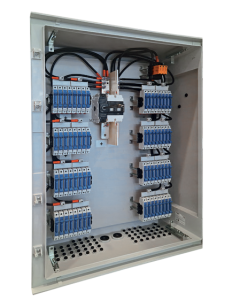
Solar combiner boxes are a fundamental component in photovoltaic (PV) systems, designed to streamline and safeguard the electrical system within a solar power setup. These devices play a crucial role in managing the energy output from multiple solar panels, making them essential for both residential and commercial solar installations. This article delves into the composition, functionality, applications, and benefits of solar combiner boxes.
What is a Solar Combiner Box?
An electrical distribution box, a solar combiner box combines the outputs of multiple solar panels into a single electrical circuit. It significantly simplifies the wiring and protects the system by housing overcurrent protection devices (such as fuses or circuit breakers) for each input line. Typically placed between the solar panels and the solar inverter, the combiner box serves as a pivotal point for consolidating the electrical output before converting it from direct current (DC) to alternating current (AC).
Composition and Manufacturing
Manufacturers construct solar combiner boxes from durable, weather-resistant materials capable of withstanding harsh environmental conditions typical of outdoor solar installations. They typically use non-corrosive metals or heavy-duty plastic and equip them with gaskets and seals to prevent moisture ingress. Inside, they contain multiple electrical components such as circuit breakers or fuse holders, busbars for distributing power, and often include monitoring equipment to oversee voltage and current for each string of solar panels.
Applications and Functionality
The primary function of a solar combiner box is to combine the output from several solar panel strings into a single conduit, reducing the complexity of the wiring system and minimizing power loss. This setup is particularly beneficial in large-scale solar projects, where managing numerous individual panel outputs would be impractical and unwieldy.
By centralizing the connections, the combiner box also facilitates easier maintenance and troubleshooting, allowing for quick disconnection and protection of individual solar panel arrays without affecting the entire system.
Benefits and Characteristics
Efficiency and Safety: Solar combiner boxes enhance the overall efficiency of solar power systems by minimizing energy loss through well-organized cable management. They also increase safety by incorporating protective features that prevent electrical faults such as overcurrents, which could lead to fires or damage.
Scalability and Flexibility: These devices allow for easy expansion of solar systems. Additional panels or strings can be integrated without significant rewiring, offering flexibility as energy needs grow.
Durability and Reliability: Designed to endure outdoor conditions, combiner boxes are built to be durable and reliable, often featuring IP-rated enclosures to protect against dust and water ingress.
Conclusion
In conclusion, solar combiner boxes are indispensable in the efficient and safe operation of solar power systems. They simplify the electrical challenges associated with managing multiple solar panel outputs, enhance safety through centralized circuit protection, and provide durability needed for long-term outdoor use. As solar energy continues to gain traction as a preferred sustainable power source, the role of solar combiner boxes in optimizing and protecting these systems remains pivotal.

